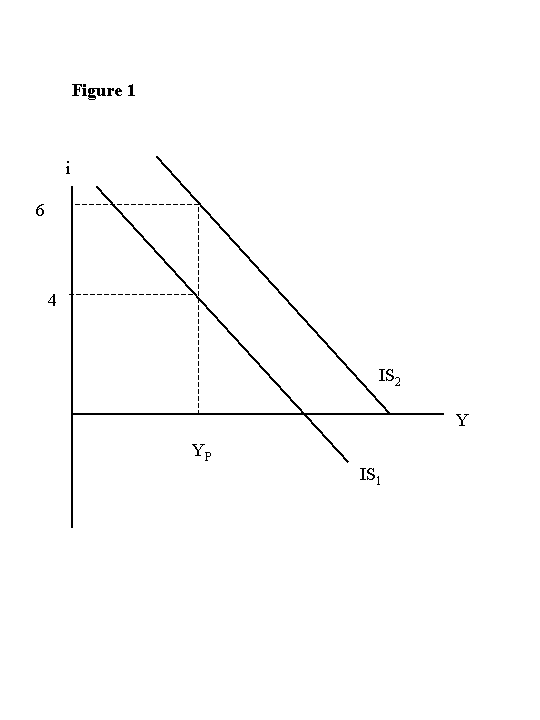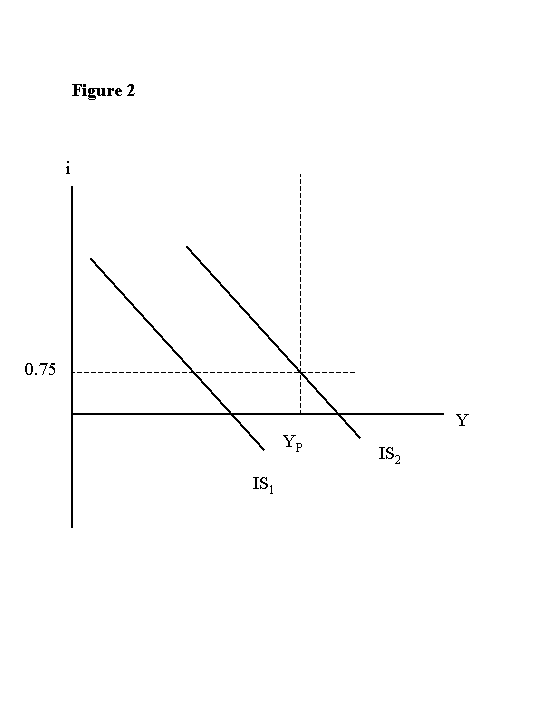SYNOPSIS: This piece is a companion to this one and this one, and the three address some critics' false accusations of arithmetic problems in his 4.22.03 NYT piece.
Hey, this is turning into a seminar. Anyway, a bit more about the relationship
between liquidity trap or near-trap conditions, fiscal policy, and jobs.
For this one, let's take the price level as given and do a bit of IS-LM.
Figure 1 represents the normal state of the economy. The IS curve looks
like IS1, YP is potential output, the Fed controls
the interest rate. What the Fed will try to do is steer the economy to
potential output; in this case, that would require an interest rate of
4 percent. In reality, of course, the Fed never hits the target exactly
- lags, uncertainty, etc. - but let's ignore all that.
Now suppose that President Hillary Clinton pushes through a huge public
works program. This pushes the IS curve to the right, to IS2.
So output would rise at any given interest rate. But the Fed isn't passive:
it will try to offset the fiscal expansion to avert overheating. In this
case that would require raising the interest rate to 6. Again, let's ignore
the uncertainties: on average, a fiscal expansion will have no effect on
output or employment, it will simply lead to higher interest rates.

But there are limits to how low the Fed can push interest rates. Zero
is obviously a lower bound: at that point cash dominates securities. The
Fed actually sets the bound higher: it believes that pushing rates below
0.75 would drive mutual funds out of business, damaging the financial system's
"plumbing". And what happens if 0.75 isn't low enough?
Figure 2 illustrates the situation. Here we assume that the current
IS curve, IS1, is so far to the left that even at a 0.75 percent
rate the economy will operate below potential. We already knew from Japan
that this was a possibility; now, with the US economy still depressed at
a Fed funds rate of 1.25, it has effectively happened here.
In this situation fiscal policy can create jobs. If Hillary's
jobs program pushes the IS curve right, to IS2, it allows the
economy to produce at potential.

As I said, we're in that situation now. But it is a very unusual situation,
brought on (we think) by special circumstances: an overhang of excess investment
in telecoms, an overhang of debt from the boom, investor distrust because
of corporate scandals, and general post-bubble retrenchment. The Fed thinks
that any day now the IS curve will shift from IS1 to IS2
all by itself, as companies start investing again. Others, myself included,
are less sure. But most economists think that we will be out of the range
in which Fed policy is unable to achieve potential output within a year
or two.
As long as 0.75 percent isn't low enough to get to YP, fiscal
expansion does create jobs. But as soon as the economy has emerged from
that situation, and the Fed raises rates above 0.75 percent, fiscal policy
doesn't create jobs. We're back to the case in which fiscal expansion drives
up interest rates, without a positive effect on employment.
And now, back to the Bush tax cut. It creates jobs, if it does, only
while the liquidity trap or near-trap lasts. After that, employment is
the same as it would be without the tax cut. So the jobs created in the
first year or two go away. Repeat, the jobs go away. OK?
But wait: did I just make this stuff up after the fact, in the face
of controversy? No: you can find the same argument - that under normal
circumstances the Fed determines the level of employment, regardless of
fiscal policy - in my 1997 Slate piece
on "Vulgar Keynesians".
Originally published on the Official Paul Krugman Page, 4.29.03

